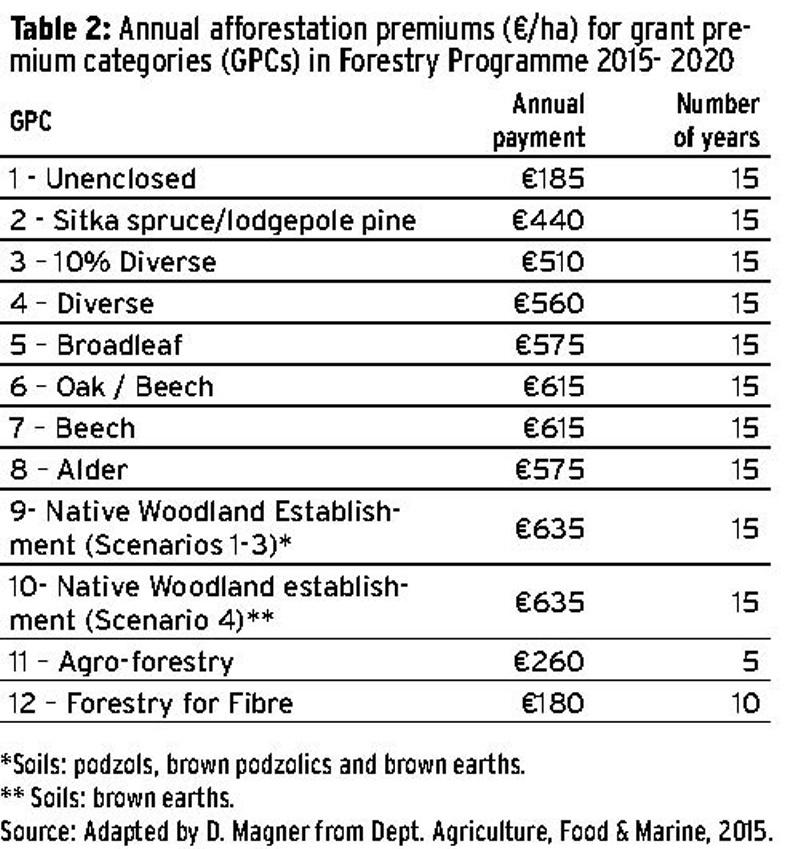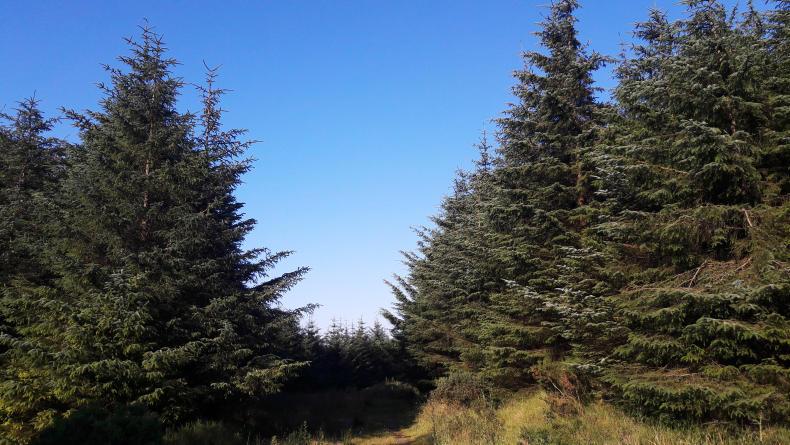Forestry has to compete with other farming and non-farming enterprises, but as Mary Ryan and Cathal O’Donoghue demonstrate, forestry is a better commercial land use option than cattle and sheep farm systems on marginal land, even allowing for the long-term nature of forestry.
but as Mary Ryan and Cathal O’Donoghue demonstrate
The incentives are attractive, as timber prices have held up remarkably over the years while all income is tax-free.
Up to €635/ha annual premia
The major disadvantage in planting trees is the reduction in the value of land in the short-term partially due to the lead-in time before the crop reaches productivity and the commitment by the owner to continue in forestry. However, this is compensated by grants of up to €5,750/ha to establish the forest and annual premium payments up to €635/ha depending on tree species.

Support measures are in place during the non-productive phase including thinning grants for broadleaves and forest roading grants prior to harvesting.
Other factors may also influence the decision to plant.
For example non-farmers, leasing land and farmers who availed of the Early Retirement Scheme are now eligible for the forestry programme. Eligible land under the Basic Payment Scheme (BPS) that is afforested under the Forestry Programme 2014-2020 can be used to activate BPS entitlements.
Risk factor
The risk factor is partially covered by reconstitution grants in the case of windblow and disease, but fire is the owners’ responsibility so fire insurance is advised.
The scheme is currently being assessed as part of a mid-term review and the IFA has raised a number of issues including the removal of restrictions on planting productive marginal land and compensating farmers appropriately for all land they are obliged to set aside for environmental enhancement and reducing red tape in the forest road scheme as timber mobilisation increases in importance.
Despite the benefits of forestry, farmers have reduced planting in recent years, especially in Munster.
To counteract this downturn, a realistic approach is required to planting marginal but productive unenclosed land and to revisit the 167,115ha of hen harrier SPAs affected by a blanket ban, which, as John Roche of The Forestry Company points out in this supplement, has devalued viable productive forestry land.
Read more
Keeping forest harvesting on track
Forestry programme needs a kick-start
Diminishing afforestation programme
Full coverage of our forestry focus
Forestry has to compete with other farming and non-farming enterprises, but as Mary Ryan and Cathal O’Donoghue demonstrate, forestry is a better commercial land use option than cattle and sheep farm systems on marginal land, even allowing for the long-term nature of forestry.
but as Mary Ryan and Cathal O’Donoghue demonstrate
The incentives are attractive, as timber prices have held up remarkably over the years while all income is tax-free.
Up to €635/ha annual premia
The major disadvantage in planting trees is the reduction in the value of land in the short-term partially due to the lead-in time before the crop reaches productivity and the commitment by the owner to continue in forestry. However, this is compensated by grants of up to €5,750/ha to establish the forest and annual premium payments up to €635/ha depending on tree species.

Support measures are in place during the non-productive phase including thinning grants for broadleaves and forest roading grants prior to harvesting.
Other factors may also influence the decision to plant.
For example non-farmers, leasing land and farmers who availed of the Early Retirement Scheme are now eligible for the forestry programme. Eligible land under the Basic Payment Scheme (BPS) that is afforested under the Forestry Programme 2014-2020 can be used to activate BPS entitlements.
Risk factor
The risk factor is partially covered by reconstitution grants in the case of windblow and disease, but fire is the owners’ responsibility so fire insurance is advised.
The scheme is currently being assessed as part of a mid-term review and the IFA has raised a number of issues including the removal of restrictions on planting productive marginal land and compensating farmers appropriately for all land they are obliged to set aside for environmental enhancement and reducing red tape in the forest road scheme as timber mobilisation increases in importance.
Despite the benefits of forestry, farmers have reduced planting in recent years, especially in Munster.
To counteract this downturn, a realistic approach is required to planting marginal but productive unenclosed land and to revisit the 167,115ha of hen harrier SPAs affected by a blanket ban, which, as John Roche of The Forestry Company points out in this supplement, has devalued viable productive forestry land.
Read more
Keeping forest harvesting on track
Forestry programme needs a kick-start
Diminishing afforestation programme
Full coverage of our forestry focus












SHARING OPTIONS